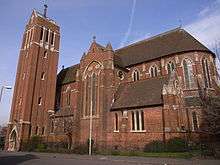St Alban the Martyr, Birmingham
| St Alban the Martyr, Birmingham | |
|---|---|
| Church of St Alban and St Patrick, Highgate, Birmingham | |
 St Alban the Martyr, Birmingham | |
| 52°27′57″N 1°53′18″W / 52.46583°N 1.88833°WCoordinates: 52°27′57″N 1°53′18″W / 52.46583°N 1.88833°W | |
| Location | Conybere Street, Highgate, Birmingham |
| Country | England |
| Denomination | Church of England |
| Churchmanship | Anglo-Catholic |
| Website |
www |
| History | |
| Dedication | Saint Alban |
| Consecrated | 4 December 1899 |
| Architecture | |
| Heritage designation | Grade II* listed |
| Designated | 25 April 1952 |
| Architect(s) | John Loughborough Pearson |
| Architectural type | Gothic revival architecture |
| Groundbreaking | 1880 |
| Completed | 1881 |
| Construction cost | £20,000 |
| Specifications | |
| Length | 130 feet (40 m) |
| Width | 76 feet (23 m) |
| Nave width | 26.5 feet (8.1 m) |
| Height | 170 feet (52 m) |
| Administration | |
| Parish | Highgate |
| Deanery | Central Birmingham |
| Archdeaconry | Birmingham |
| Diocese | Anglican Diocese of Birmingham |
St Alban the Martyr, Birmingham is a Grade II* listed Church of England parish church in the Anglican Diocese of Birmingham.[1] It is dedicated to Saint Alban, the first British Christian martyr.[2]
History
A temporary church was established as a mission of Holy Trinity Church, Bordesley in 1865, and a temporary church was opened on 13 September 1866.[3]
The permanent church was designed by John Loughborough Pearson and built by the contractor Shillitoe of Doncaster.[4] Work started in 1880 and the church was opened in 1881. The formal consecration took place on 4 December 1899.[5] The construction cost was in the region of £20,000 (equivalent to £2,004,514 in 2016).[6]
The patron is Keble College, Oxford.
St Alban's Church took over the parish of St Patrick's Church, Bordesley when St Patrick's was demolished in the early 1970s.
Present day
St Alban's Church stands in the Anglo-Catholic tradition of the Church of England. The parish had passed Resolutions A and B of the Priests (Ordination of Women) Measure 1993, meaning they rejected the ordination of women, but these expired in 2016.[7] They also voted on Alternative Episcopal Oversight, but this was rejected. In 2017, they voted on the replacement of Resolutions A and B, the Resolution under the House of Bishops' Declaration: "This was not carried, with equal votes for and against."[8] This means that the parish would now accept a woman priest.
Architecture
The cruciform building is in red brick, with dressings in ashlar. The tower and spire were added in 1938 by Edwin Francis Reynolds. The interior features a stained glass east window by Henry Payne and, in the south chapel, a copper Arts and Crafts triptych with painted panels, by local artists Kate and Myra Bunce[9] and donated by them in 1919 in memory of their sisters and parents.[5]
A Birmingham Civic Society blue plaque honouring the Bunce sisters was unveiled at St Alban's in September 2015, by the Lord Mayor of Birmingham.
Vicars
- 1865 – 1894: James Samuel Pollock
- 1895 – 1896: Thomas Benson Pollock
- 1897 – 1900: George Philip Trevelyan
- 1900 – 1910: Canon Alfred Cecil Scott
- 1910 – 1911: Mark Napier Trollope
- 1911 – 1923: Francis Underhill
- 1923 – 1953: Dudley Clark
- 1953 – 1981: Canon Lawrence Goodrich Harding
- 1982 – 1986: David Handley Hutt
- 1987 – 1993: Michael Hedley Bryant
- 1995 – 2004: Canon James G. Pendorf
- 2005 – 2010: Canon John Hervé
- 2011 – 2013: Dr Pervaiz Sultan
- 2013 – 2016: Dr Nicholas lo Polito
Organ
The organ dates was installed second-hand in 1870 and was by Bryceson Son & Ellis. It was overhauled in 1940 by Rushworth and Dreaper of Liverpool who extended the compass to C and added electro-pneumatic action. The Pedal Trombone, Great Tuba and Swell 5-rank mixture were added at this date. A new oak organ case was created by Birmingham Sculptors Ltd and Craftinwood Ltd.[10] A specification of the organ can be found on the National Pipe Organ Register.[11]
See also
References
- ↑ The buildings of England. Warwickshire, Nikolaus Pevsner
- ↑ Thurston, Herbert. "St. Alban." The Catholic Encyclopedia. Vol. 1. New York: Robert Appleton Company, 1907. 19 February 2013
- ↑ "Dedication Services at St Alban's". Birmingham Journal. Birmingham. 15 September 1866. Retrieved 26 March 2015.
- ↑ "The Church of St Alban, Birmingham". Birmingham Daily Post. Birmingham. 29 April 1881. Retrieved 26 March 2015.
- 1 2 S. Alban and S. Patrick, Birmingham 12. St Alban's. Undated (circa 1984-1986). Check date values in:
|date=(help) - ↑ UK Retail Price Index inflation figures are based on data from Clark, Gregory (2017). "The Annual RPI and Average Earnings for Britain, 1209 to Present (New Series)". MeasuringWorth. Retrieved 6 November 2017.
- ↑ "About our community". St Alban the Martyr, Birmingham. Retrieved 13 May 2017.
- ↑ "Parochial Church Council of Saint Alban and Saint Patrick Highgate, Birmingham: Parish Statement" (PDF). St Alban the Martyr, Birmingham. February 2017. pp. 3, 13. Retrieved 13 May 2017.
- ↑ Historic England. "Details from listed building database (1290539)". National Heritage List for England. Retrieved 7 July 2015.
- ↑ "Reconstruction Work Completed". Birmingham Daily Post. England. 22 May 1940. Retrieved 26 December 2016 – via British Newspaper Archive. (Subscription required (help)).
- ↑ St. Alban and St. Patrick, Conybere Street from The National Pipe Organ Register, retrieved 4 March 2015
External links
| Wikimedia Commons has media related to St Alban's Church, Highgate. |